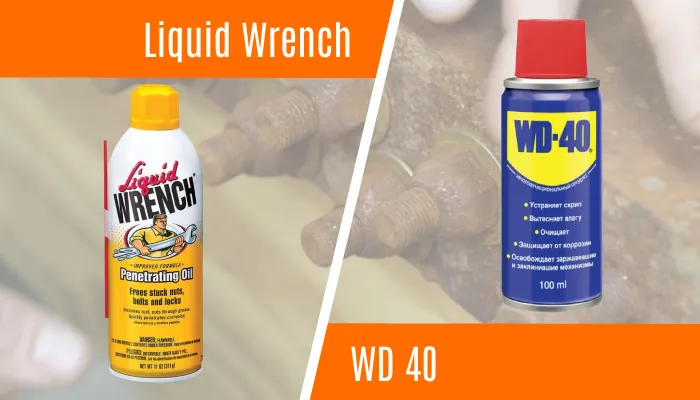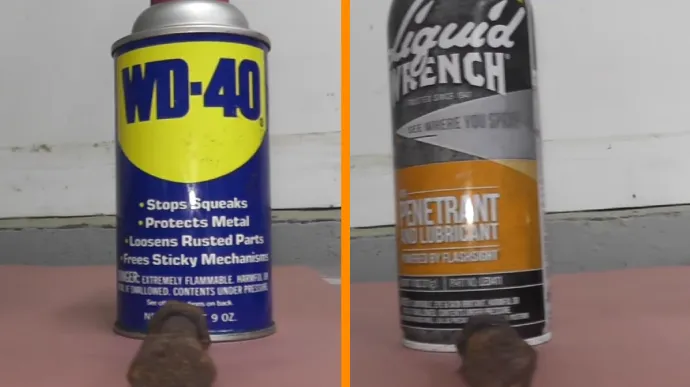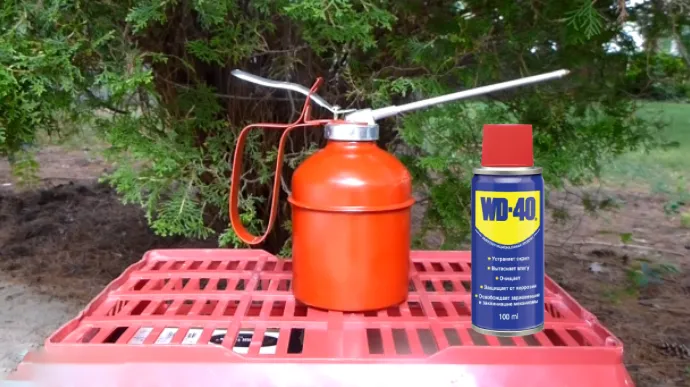Physical Address
304 North Cardinal St.
Dorchester Center, MA 02124
Physical Address
304 North Cardinal St.
Dorchester Center, MA 02124

The choice of the right maintenance and repair products for your vehicle is crucial to ensure its long-term durability and optimal performance. Among the array of options available, two commonly used products for vehicle applications are WD-40 and Liquid Wrench.
Liquid Wrench is specifically designed as a penetrating oil, excelling in breaking down rust and corrosion on vehicle components. This makes it ideal for freeing rusted bolts and nuts.
In contrast, WD-40, while effective in penetrating rust, offers a broader range of applications, including lubrication, moisture displacement, and rust prevention.
Here, we’ll explore the characteristics of each product, helping you make an informed choice. From penetrating power to long-lasting lubrication, we’ll break down the technicalities to help you decide what’s right for your vehicle.

When comparing Liquid Wrench and WD-40 for vehicle applications, you should consider their chemical properties and ingredient differences.
WD-40 is composed of a mixture of various chemicals, including petroleum-based components. These components give WD-40 its characteristic properties, such as lubrication and moisture displacement.
On the other hand, Liquid Wrench utilizes a different set of chemicals that are specifically designed to penetrate and dissolve rust. It focuses on loosening seized or stuck parts by breaking down rust and corrosion.
WD-40’s petroleum-based components make it an effective lubricant, while Liquid Wrench’s rust-dissolving chemicals make it ideal for removing rust from vehicles.
WD-40 is well-known for its exceptional water displacement properties, making it highly effective in preventing moisture-related corrosion. When applied to metal surfaces, WD-40 forms a protective barrier that repels water, preventing it from coming into contact with the metal and causing rust.
This is particularly important for vehicles exposed to water or moisture, such as those driven in rainy or humid climates.
In contrast, Liquid Wrench doesn’t possess the same level of water displacement capability as WD-40 and may not provide the same level of rust protection. Due to this, Liquid Wrench is less suitable for use on metal surfaces in areas exposed to water or moisture.
WD-40, with its multi-purpose nature, offers a broad spectrum of applications. It excels in lubrication, rust prevention, and cleaning, making it an all-in-one solution for a variety of vehicle parts, such as hinges and locks.
Conversely, Liquid Wrench is more specialized, focusing primarily on freeing rusted or corroded parts. While it may not have the same level of versatility as WD-40, it excels in its specific area of expertise.
When selecting a product for vehicle applications, it’s important to consider the temperature range in which it will perform optimally.
WD-40 offers a wide temperature tolerance, making it suitable for various vehicle applications in both hot and cold environments. It can operate effectively in temperatures as low as -100°F and as high as 500°F.
This versatility allows WD-40 to handle extreme temperature conditions and remain effective in a wide range of situations.
On the other hand, Liquid Wrench has more limited temperature constraints. It typically performs optimally in temperatures ranging from -20°F to 150°F. Therefore, WD-40 may be a more suitable option for your vehicle applications if you anticipate encountering temperature extremes outside of this range.
To apply these products to your vehicle, you can use different methods based on the specific needs of your maintenance tasks.
WD-40 is often equipped with a precision straw, allowing for targeted application. This makes it well-suited for tasks such as freeing stuck mechanisms or lubricating specific areas. The precision straw enables you to reach tight spaces and apply the product with accuracy.
Alternatively, Liquid Wrench comes with a specialized nozzle designed for precise application. This makes it ideal for automotive maintenance and home repairs. The specialized nozzle ensures the product is applied accurately and evenly, enhancing its effectiveness.
You can choose from different dispensing methods for precise and efficient application of Liquid Wrench and WD-40 to your vehicle.
WD-40 offers a range of application options, including aerosol sprays, drip bottles, and bulk containers. This versatility allows you to select the most convenient method for vehicle maintenance. Whether you prefer a controlled spray, a targeted drip, or a larger quantity for bulk applications, WD-40 has you covered.
In contrast, Liquid Wrench may have fewer options for dispensing methods. While it’s also available in aerosol sprays, the choices may be more limited. Therefore, it’s important to consider your preferred method of application when deciding between Liquid Wrench and WD-40 for your vehicle maintenance needs.

If you want to effectively loosen rusted bolts on your vehicle, using a penetrating fluid like Liquid Wrench is better than using WD-40. While both products have their uses, penetrating fluids are specifically formulated to tackle rust and corrosion.
Penetrating fluids, such as Liquid Wrench, contain specialized ingredients that can break down rust and penetrate deep into the threads of a bolt. This allows the fluid to work into the tight spaces and crevices, effectively loosening the rusted bolt.
As opposed to that, WD-40, a versatile lubricant, isn’t specifically designed to eliminate corrosion. It may provide some temporary lubrication, but it lacks the penetrating properties of a dedicated penetrating fluid.
WD-40 is known for its long-lasting lubrication properties that can effectively protect against rust and moisture for an extended period. With WD-40 Specialist Gel Lube No-Drip Formula, you’ll get superior protection that resists water, displaces moisture, and prevents rust for up to one year.
This means that once applied, WD-40 can continue to provide lubrication and protection for an extended duration, reducing the need for frequent reapplication.
Liquid Wrench is designed to effectively dissolve and remove rust, grease, and other tough contaminants as a highly volatile solvent.
Its unique formula allows it to penetrate tight spaces and loosen stuck or seized parts, making it an ideal choice for mechanics and automotive enthusiasts. Liquid Wrench can be used on various vehicle components such as bolts, nuts, hinges, and locks to ensure smooth operation and prevent corrosion.
Its solvent properties enable it to break down and dissolve stubborn residues, making cleaning and maintaining vehicles easier.
Liquid Wrench contains a mixture of solvents and propellants, which make it highly combustible. The aerosol can contain gas under pressure, which may explode if exposed to temperatures above 150°F.
It’s crucial to handle the Liquid Wrench with caution and keep it away from any potential ignition sources, such as open flames or sparks. Additionally, storing this product in a cool, dry place is essential to minimize the risk of fire.
In the vast realm of vehicle maintenance, both Liquid Wrench and WD-40 have unique qualities.
While both products have their merits, Liquid Wrench excels in penetrating rusted or corroded parts, making it an ideal solution for freeing stubborn fasteners.
On the other hand, WD-40 offers a broader range of uses, including water displacement, rust protection, and versatile lubrication. This makes it a valuable multi-purpose tool for various vehicle maintenance tasks.
Furthermore, Liquid Wrench acts as a solvent, making it ideal for dissolving tough substances. However, you should note that Liquid Wrench and WD-40 are flammable.
So, choose wisely, as these products can be valuable assets for running your vehicle smoothly.